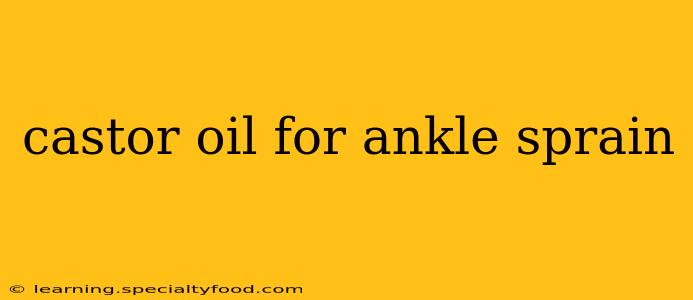Ankle sprains are a common injury, often resulting from a sudden twist or turn of the foot. While conventional treatments like RICE (Rest, Ice, Compression, Elevation) and physical therapy are widely recommended, some individuals explore alternative remedies like castor oil. But does castor oil actually help with ankle sprains? Let's delve into the evidence and explore its potential benefits and drawbacks.
What is Castor Oil?
Castor oil is a vegetable oil pressed from the seeds of the Ricinus communis plant. It's known for its thick, viscous consistency and has been used for centuries in traditional medicine for various purposes, including skin conditions and inflammation. Its purported benefits often stem from its high ricinoleic acid content, which some believe possesses anti-inflammatory properties.
Can Castor Oil Reduce Ankle Swelling?
This is a common question surrounding castor oil's use for ankle sprains. While anecdotal evidence suggests castor oil might reduce swelling, there's currently a lack of robust scientific studies directly supporting its efficacy in treating ankle sprain swelling. Many of the purported benefits are based on its traditional uses and the general anti-inflammatory properties of ricinoleic acid, rather than specific research on ankle sprains.
Does Castor Oil Help with Ankle Pain?
Similar to swelling reduction, there's limited scientific evidence to confirm castor oil's direct pain-relieving effects on ankle sprains. While ricinoleic acid may have some anti-inflammatory potential, this doesn't automatically translate to pain relief for a specific injury like an ankle sprain. Pain management for ankle sprains typically involves RICE, over-the-counter pain relievers, and possibly physical therapy.
How to Use Castor Oil for Ankle Sprains (If Choosing to Try It)?
If you're considering using castor oil, it's crucial to approach it cautiously. There's no standardized application method for ankle sprains. Some people might choose to gently massage a small amount of warmed castor oil onto the affected area, avoiding direct contact with any open wounds. Always perform a patch test on a small area of skin first to check for any allergic reactions.
Important Note: Castor oil should not replace conventional medical treatment for ankle sprains. It's crucial to seek professional medical advice from a doctor or physical therapist for diagnosis and treatment.
Is Castor Oil Safe for Ankle Sprains?
Generally, castor oil is considered safe for topical application when used correctly. However, some individuals might experience allergic reactions such as skin rashes or irritation. Always perform a patch test before widespread application. Furthermore, castor oil ingestion is not recommended, and it's crucial to keep it away from eyes and mucous membranes.
What are Other Effective Treatments for Ankle Sprains?
Effective treatments for ankle sprains typically include the following:
- RICE: Rest, Ice, Compression, Elevation. This remains the cornerstone of initial ankle sprain management.
- Over-the-counter pain relievers: Ibuprofen or naproxen can help manage pain and inflammation.
- Physical therapy: A physical therapist can guide you through exercises to strengthen the ankle and improve range of motion.
- Bracing or taping: Supportive devices can help stabilize the ankle and prevent further injury.
- Medical attention: In severe cases, a doctor may recommend further evaluation, including X-rays to rule out fractures.
Conclusion: Proceed with Caution
While castor oil has a history of use for various inflammatory conditions, its effectiveness for ankle sprains lacks robust scientific backing. It should never replace conventional medical treatment. If you experience an ankle sprain, it's vital to seek professional medical attention for proper diagnosis and treatment. Castor oil, if used at all, should be considered a complementary approach, used cautiously and with careful attention to any potential allergic reactions. Always prioritize evidence-based treatments for optimal recovery.
